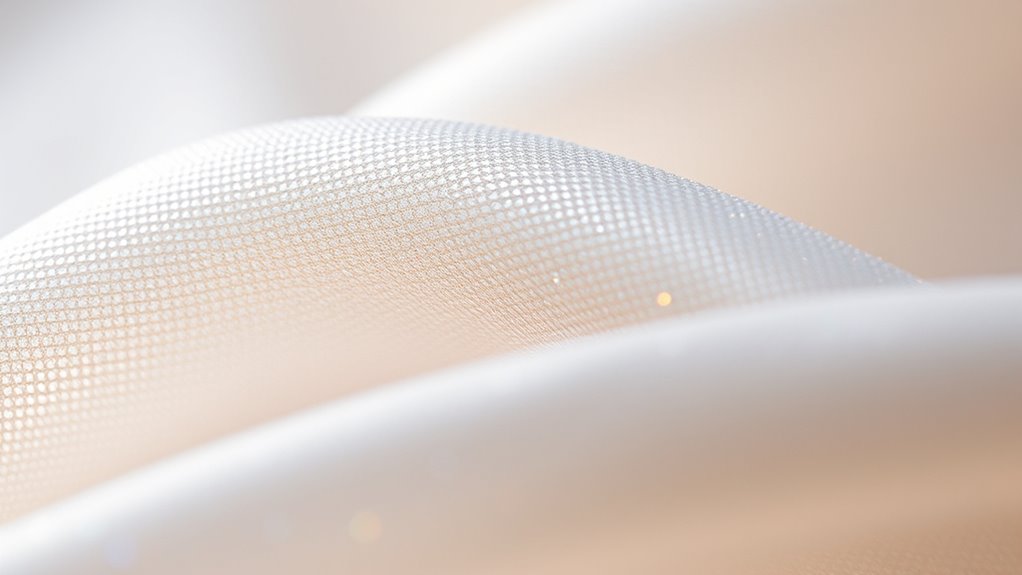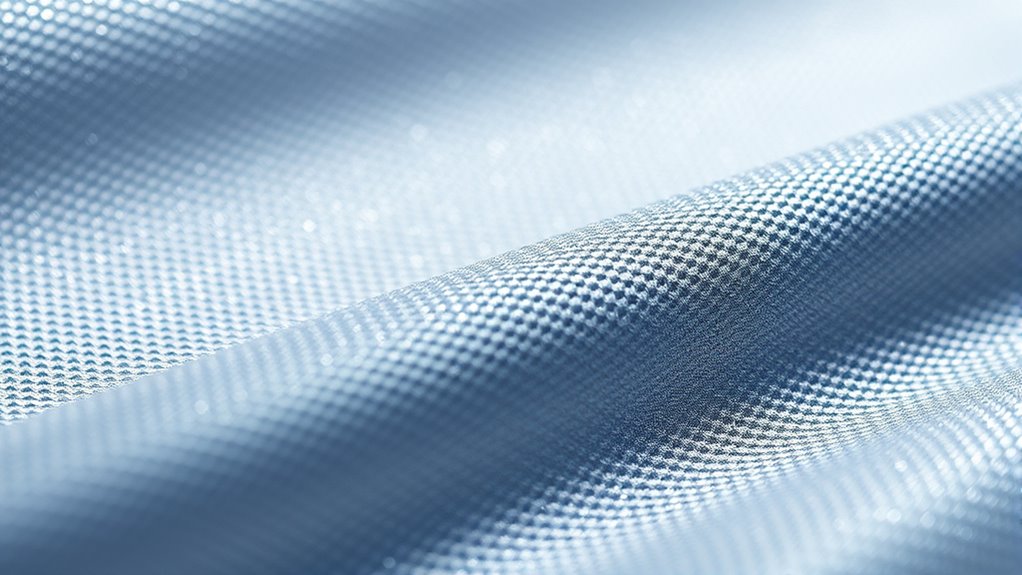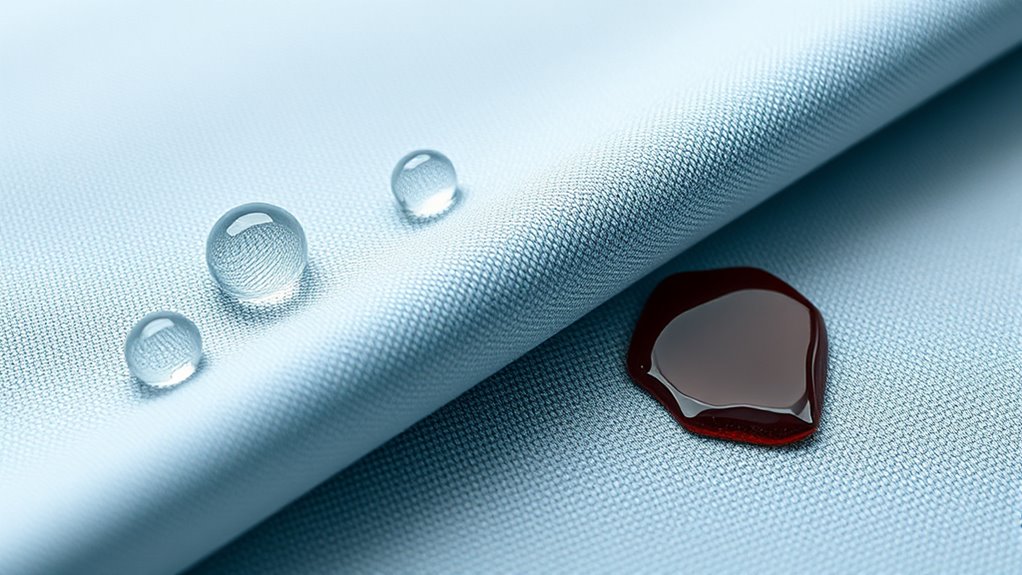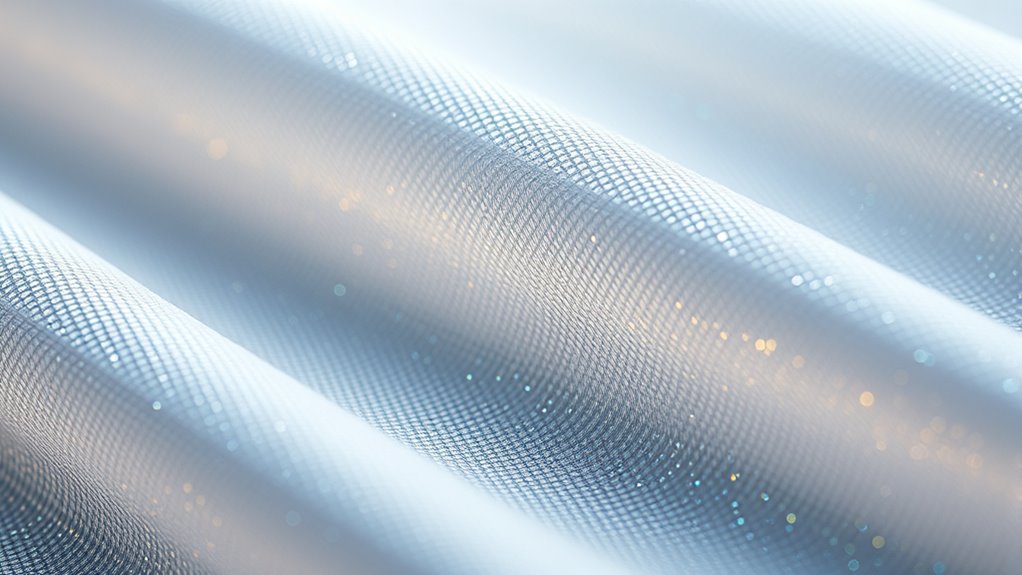Nanotechnology enhances textiles by making them more durable, functional, and environmentally friendly. You can find fabrics with antimicrobial properties, vibrant long-lasting colors, and surfaces that resist water, stains, and UV damage. Smart textiles with embedded sensors can respond to environmental changes, offering new levels of comfort and safety. Additionally, nanotech reduces environmental impact and extends fabric lifespan. To discover how these innovations can transform your textiles, continue exploring the exciting advancements in nanotechnology.
Key Takeaways
- Nanotechnology enhances textiles by improving durability, antimicrobial properties, and resistance to environmental damage.
- Nanomaterials enable water- and stain-repellent fabrics through superhydrophobic nanocoatings.
- Smart textiles utilize nanosensors and actuators for environmental sensing and adaptive functions.
- Nanostructures provide UV protection, increased lifespan, and maintain fabric aesthetics after washing.
- Sustainable nanotech approaches extend fabric life and reduce environmental impact, with safety considerations for nanoparticle use.
Advances in Nanomaterials for Textile Enhancement

Recent developments in nanomaterials have markedly improved textile properties, offering enhanced durability, functionality, and aesthetics. As you incorporate nanomaterials, you’ll notice your fabrics becoming stronger and more resistant to wear without added weight. Nanoparticles like silver and zinc oxide provide antimicrobial properties, keeping textiles fresh longer. You can also achieve vibrant, long-lasting colors through nanocoatings that resist fading from washing or sunlight. Additionally, nanostructures enable textiles to repel liquids, making them waterproof yet breathable. These advancements allow you to create innovative fabrics suited for various applications, from sportswear to medical textiles. By integrating nanomaterials, you *disclose* new possibilities for high-performance, visually appealing, and functional textiles that meet modern demands.
Improving Durability and Wear Resistance

Building on the advancements in nanomaterials that enhance textile functionality, focusing on improving durability and wear resistance allows you to create fabrics that stand up to daily use. Nanoparticles like nanosilica and nanoclay can be embedded into fibers to strengthen their structure, making them less prone to tearing and pilling. You can also apply nanocoatings that create a tough, protective barrier on fabric surfaces, reducing abrasion and friction damage. These coatings increase the fabric’s lifespan without adding weight or stiffness. Additionally, nanostructures can improve resistance to environmental factors like UV radiation and chemical exposure, preventing degradation over time. Incorporating UV filters into nanocoatings further enhances protection against sun damage, extending the longevity of the textiles. By integrating these nanotechnologies, you empower your textiles to maintain their appearance and performance longer, even under rigorous conditions.
Water and Stain Repellency Technologies

Nanotechnology has revolutionized water and stain repellent treatments in textiles by enabling the creation of surfaces that resist liquids at a microscopic level. Imagine a fabric where liquids bead up and roll off effortlessly, preventing stains and moisture absorption. This is achieved through nanocoatings that form a protective barrier. These treatments work by:
- Creating superhydrophobic surfaces that mimic lotus leaves, making water and spills glide away.
- Embedding nanostructures that reduce fabric porosity, blocking liquids from penetrating.
- Applying nanomaterials that bond strongly with fibers, ensuring long-lasting repellency.
With these innovations, your fabrics stay cleaner longer, resist spills, and dry faster. You get durable, maintenance-friendly textiles that perform better in everyday environments.
Smart and Functional Textiles Enabled by Nanotech

Thanks to nanotech, textiles now do much more than just cover your body—they can adapt and respond to your needs. Smart fabrics integrate nanoscale sensors and actuators that detect changes in temperature, moisture, or pressure. For example, these textiles can regulate your body temperature by adjusting insulation or releasing cooling agents when you’re hot. They also respond to environmental factors, such as blocking harmful UV rays or releasing antimicrobial agents to keep you fresh. Nanomaterials enable fabrics to change color, stretch, or harden on command, offering enhanced functionality for sports, medical, or everyday use. Additionally, understanding divorce statistics can help manufacturers tailor products for specific markets and demographic groups. This innovation transforms ordinary textiles into interactive, personalized materials that improve comfort, safety, and performance in real-time.
Sustainability and Environmental Impact of Nanofabrics

As nanofabrics become more prevalent, their environmental impact and sustainability considerations grow increasingly important. You might picture three key aspects: First, the production process could consume less water and energy, reducing your carbon footprint. Second, nanomaterials can extend fabric life, meaning fewer replacements and less waste in landfills. Third, responsible disposal and recycling of nanofabrics prevent harmful nanoparticle release into ecosystems. Additionally, the development of home theatre projectors with eco-conscious features can further lessen environmental effects. However, concerns remain about nanoparticle safety, potential toxicity, and long-term environmental effects. You need to weigh these factors carefully, ensuring that the benefits of enhanced durability and performance don’t come at the planet’s expense. Advancing sustainability in nanofabrication involves adopting eco-friendly practices, improving recycling methods, and regulating nanoparticle use to minimize ecological risks.
Frequently Asked Questions
How Do Nanomaterials Impact Textile Recyclability and End-Of-Life Disposal?
Nanomaterials can make textiles more recyclable by improving their durability and biodegradability, but they also pose challenges. You might find that nanomaterials complicate recycling processes because they can interfere with standard separation techniques or add contaminants. However, when designed responsibly, nanomaterials can enhance end-of-life disposal by enabling easier breakdown or reuse of textiles, ultimately reducing waste. It’s important to contemplate both benefits and potential environmental impacts during development.
Are Nanotech-Enhanced Textiles Safe for Sensitive Skin and Allergic Reactions?
Sure, wearing nanotech-enhanced textiles might make you feel like a superhero, but are they safe for sensitive skin? Usually, yes—most are tested thoroughly to prevent allergic reactions. However, if you have super-sensitive skin or allergies, it’s wise to check the product labels and do a patch test. After all, even superhero capes shouldn’t cause rashes, right? Stay cautious, and enjoy your high-tech wardrobe!
What Are the Cost Implications of Integrating Nanotechnology Into Textiles?
Integrating nanotechnology into textiles can increase costs due to advanced materials and manufacturing processes. You might pay more upfront for enhanced durability, stain resistance, or antimicrobial properties. However, these investments can lead to long-term savings by reducing replacement frequency and maintenance. As technology advances and scales up, expect prices to decrease. Ultimately, while initial costs are higher, the durability and specialized features can make nanotech textiles a worthwhile investment for you.
How Do Nanomaterials Affect the Breathability and Comfort of Fabrics?
You’ll find that nanomaterials often improve breathability and comfort in fabrics by creating tiny channels that promote airflow and wick moisture away. This means your clothing stays dry and cool even during intense activity. The lightweight nature of nanomaterials also adds to the comfort without sacrificing durability. As a result, you experience enhanced wearability and feel more at ease, whether you’re working out or enjoying everyday activities.
Can Nanotechnology Be Applied to Traditional Textile Manufacturing Processes?
Yes, nanotechnology can be applied to traditional textile manufacturing processes. You can incorporate nanomaterials into fibers during spinning or coating stages, enhancing properties like durability, water resistance, and UV protection. This integration often requires minimal changes to existing machinery, making it feasible for manufacturers to adopt. By doing so, you improve the fabric’s performance while maintaining production efficiency, creating advanced textiles without overhauling your current manufacturing setup.
Conclusion
Nanotechnology transforms textiles into a canvas of endless possibilities, turning ordinary fabrics into superheroes of durability, water resistance, and smart functions. As you embrace these innovations, you’re stepping into a future where fabrics are more than just clothing—they’re smart, sustainable, and resilient allies. Like a master painter with a limitless palette, nanotech gives you the power to craft textiles that not only meet your needs but redefine what’s possible in fabric technology.









